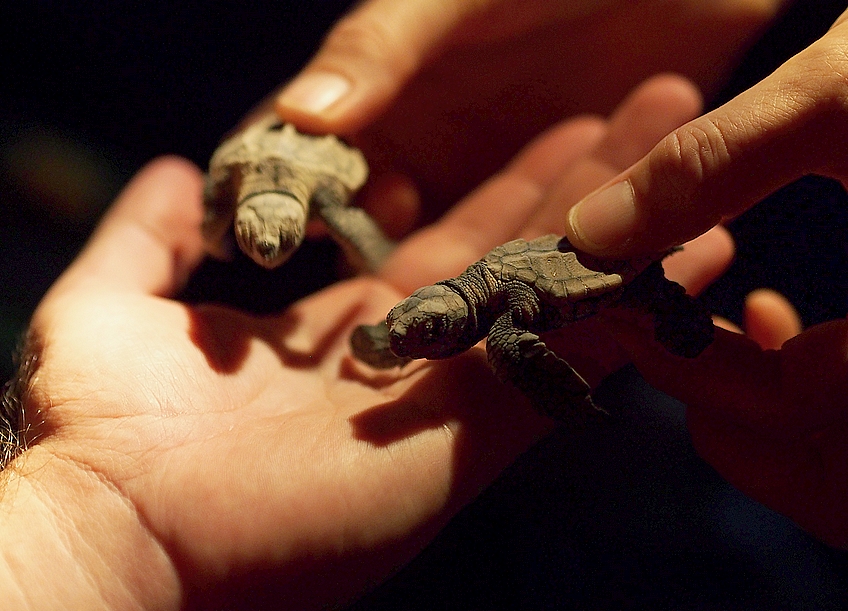








Bargara, 18 January 2014
Dusk had set in when we arrived at Mon Repos Conversation Park at 6:45 pm. We were booked in for a ranger guided turtle encounter. Prepared that this might mean long hours before anything happened on the beach we were outfitted with warm clothes and patience. However as soon as we reached the vistors center our names were called out and soon afterwards we were led down to the dark beach to watch a loggerhead turtle laying her eggs.
Turtles are easily disturbed while digging the hole, so we had to wait until she had started the egg laying process. In that stage she didn't care what was going on around her. Her name was Carapace. She had been in the turtle tracking programme for 21 years. Last time she was seen on Mon Repos beach was 6 years ago. From November till February turtles usually come 3 to 4 times to the beach to lay eggs. But this was Carapace's first time this season. The ranger assumed she might have layed her eggs somewhere else before though this is quite unusual as turtles like salmon tend to return to their birth place. Our guide had just started to show around one of her eggs, when Carapace started to digg in her eggs and he had to hurry to


Double click to edit
lay it back. This was unusual too for normaly turtles lay well above 100 eggs, but Carapace finished after approx 30 eggs. He said she was the fifth turtle this year, who had laid so few eggs. The rangers hadn't yet a clue what was causing this.
We watched her burrying her clutch and returning to the sea. It was beautiful to observe how she glided into the water when the first waves met her. Suddenly her movement were all elegance. When we returned to the center I asked our guide, if we could go down to the beach a second time as I would really love to see the little turtles hatch. She said we could chance it, but we would have to wait until the last group had gone on the beach, which might mean a couple of hours waiting. There is no guarantee about animal activity during the night. And there would also be no guarantee, if our next encounter would be an egg laying turtle or hatching. As it was only 8 pm my friends and I decided we would wait till 9 pm. Maybe we were lucky. We were just queuing for our turtle certificate, when the 5th and last group was called onto the beach and we had only just received our certificates, when the rangers asked who would like to return to the beach to watch an egg laying turtle. It would be the last tour for the night. Well no hatching we thought, but we didn't want to miss a moment of this special night, so we joined the group.
While we were led along the beach another loggerhead turtle crawled out of the waves and approached the dunes to find a nesting place. Normally the tourists were no allowed to watch the digging process as the turtle could be easily disturbed. But when it was clear in which direction she was looking we were allowed to approach her from the other side and settle down quietly. She worked hard to remove the sand, but unfortunately she was hindered by thick roots. She turned and tried again facing us directly. Everybody was very still to avoid to scare her. She put down a lot of effort without success. After what felt like half an hour she gave up and returned to the sea. She might have tried again the following night.
As we were returning to the center our guide was conferring with a collegue, who was watching turtles hatching with her group. We were allowed to join them just when two rangers were showing around the little beings. They have about the length of my index finger. After everybody had a good look we could observe how another little being stuck its nose out of the sand and wondered, if it really should emerge into the black of the night. After a couple of minutes it started undigging itself and was immediatly captured after its first few steps. The ranger searched for another nose and the process began again. They had collected seven little turtles for their run to the sea. To find their way to the ocean the hatchlings orientate themselves to the lowes visible light, which is usually the moonlight on the water. When the hatching beach is near inhabited area they can be easily misguided by car lights or lights from houses. That's why the rangers take great care that nobody is photographing without permission or holding a torch or anything that could irritate either the hatchlings or scare the egg laying turtle mums.
For their run to the ocean the rangers arranged a couple of kids in a row with spread legs and a torch in their hand to guide the hatchlings to the water. Then the little ones were let loose. With their little flippers they worked their way through the sand. Little dents were posing a major challenge as these mini hills must have seemed like mountains to the tiny loggerheads. One of them always went astray but was readily caught by a ranger and put back into track. One by one they reached the surf and suddenly they dived into it and dissappeared. We were left alone under the starry sky of Australia full to the rim with fondness for what we had seen this night.
Carapace
Carapace - tag number K55995











